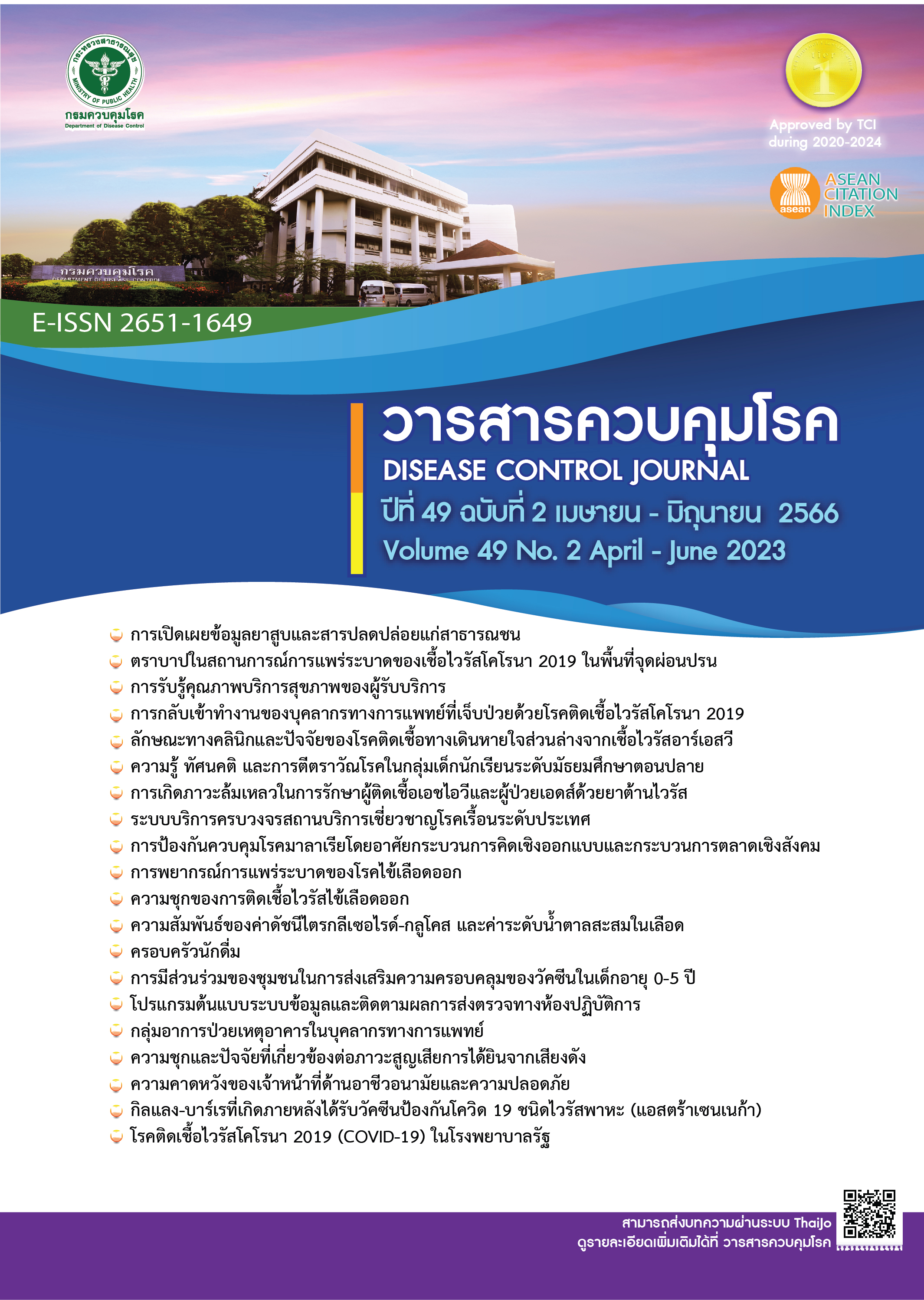Innovation prototype program for Situation Awareness Team and Joint Investigation Team Laboratory (SAT&JIT Lab) in the Office of Disease Prevention and Control, Region 9 Nakhon Ratchasima, 2020
DOI:
https://doi.org/10.14456/dcj.2023.35Keywords:
data system, follow-up laboratory results, surveillance and investigationAbstract
The Office of Disease Prevention and Control Region 9, Nakhon Ratchasima Province has a mission for supporting laboratory tests to confirm the pathogens or causes of the diseases and health threats for health facilities under the Health Region 9 networks. In the past, laboratory results and expenses were provided and managed in a paper-based format. Therefore, a web-based application was developed to record those data for more efficient data review and utilization. The program for laboratory data recording was designed and developed following a five-step design thinking. The first four steps were a research phase consisting of 1) clearly understanding the target audience/end user, 2) identifying problems, 3) brainstorming, and 4) developing a prototype. The fifth step, a development phase, was testing and improving the program. The efficacy and efficiency of the program was evaluated by weekly monitoring of the use by sample users and determining the users’ satisfaction between pre- and post-improving the program. User satisfaction was measured using the form developed by the Division of Innovation and Research, Department of Disease Control. User sampling was purposively selected. A total of 40 users related to the program were recruited. Descriptive statistics used for data analysis included number, percentage, mean, and standard deviation and mean values were tested using dependent t-test. In 2020 this web-based application was accessed and used 232 times for the purposes of supporting disease surveillance and investigation efforts. The application was most frequently used for searching and retrieving expenses associated with laboratory tests (25.4% of the total use). This was followed by reviewing laboratory results (24.6%) and searching data and information for preparations of executive summaries (23.3%). In terms of the efficiency and effectiveness of the application, one case of redundant billing was identified and one case of missed billing was found. This innovative application has significantly reduced the time used for searching laboratory results from 15-20 minutes to about 3-5 minutes per time, while the time needed to check for bill payment information has substantially been reduced from 10 days to just about 5-10 minutes per time. The average satisfaction of users was increased from 3.38 at pre-use period to 3.65 at post-use period with statistical significance (p-value<0.05). It is recommended that further joint development and data sharing should be emphasized among health organizations within Health Region 9.
Downloads
References
Plattner H. An introduction to design thinking process guide [Internet]. 2021 [cited 2021 Mar 5]. Available from: https://web.stanford.edu/~mshanks/ MichaelShanks/files/509554.pdf
Department of Disease Control (TH), Division of Innovation and Research. Success level of Innovations that the agency creates and takes advantage fiscal year 2021 [Internet]. 2021 [cited 2020 Dec 1]. Available from: https://ddc.moph.go.th/psdg/pagecontent.php?page =262& dept=psdg (in Thai)
Kajornsil B. Analysis and interpretation of research data using SPSS for Window version 10-12. 2nd printing. S.P.N. company. Bangkok. 2015. (in Thai)
Taertulakarn S, Komen S. Information system for development a medical laboratory instrumental administration [Internet]. 2007 [cited 2021 Mar 2]. Available from: https://digital.library.tu.ac.th/tu_dc/frontend/Info/item/dc:87181 (in Thai)
Laosombutthawee P, Polkang B, Bunchoo O. Effectiveness the Project Tracking System. Chaiyaphum Provincial Health Office. The office of Disease prevention and control region 9 Nakornratchasima. 2022;23(3):33-43. (in Thai)
Kidjawan N. Design Thinking Process: New Perspective in Thai Healthcare System. Thai Journal of Nursing Council. 2018;33(1):5-14. (in Thai)
Supupakarn S. Learn more about Management Information Systems (MIS) [Internet]. 2018 [cited 2022 Apr 13]. Available from: https://www.scimath.org/article-technology/item/ 10477-mis (in Thai)
Simplilearn. The 6 most of popular type of information systems in their application [Internet]. 2022 [cited 2022 Apr 13]. Available from: https://www.simplilearn.com/types-of-information-systems-and-applications-article
Downloads
Published
How to Cite
Issue
Section
License
Copyright (c) 2023 Disease Control Journal

This work is licensed under a Creative Commons Attribution-NonCommercial-NoDerivatives 4.0 International License.
Articles published in the Disease Control Journal are considered as academic work, research or analysis of the personal opinion of the authors, not the opinion of the Thailand Department of Disease Control or editorial team. The authors must be responsible for their articles.






